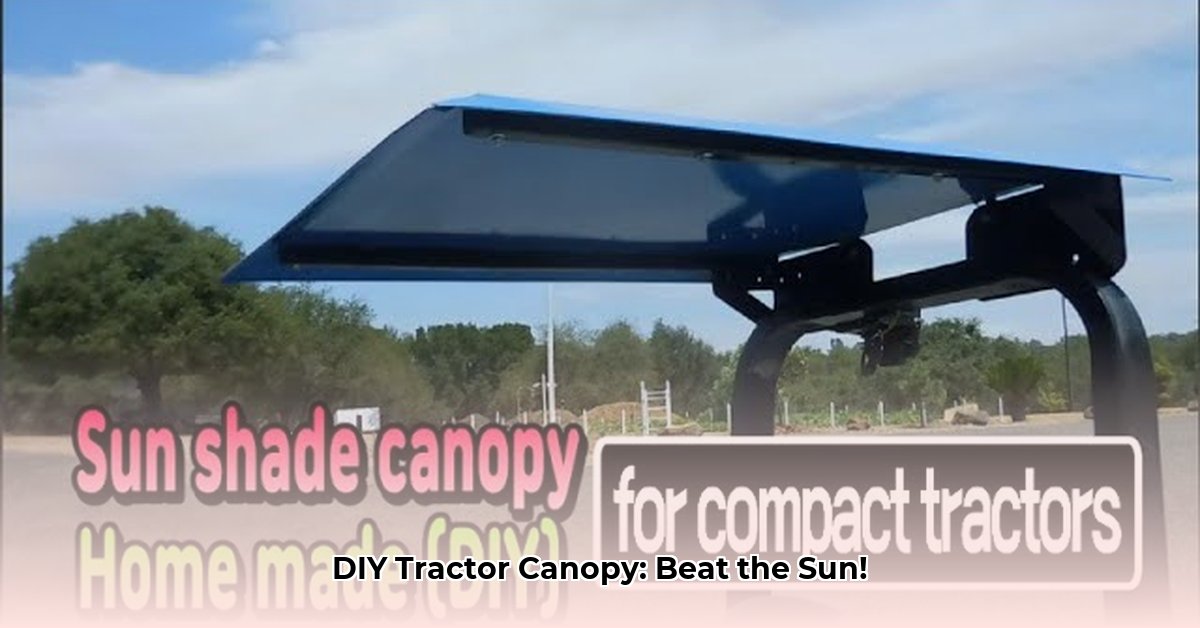
Tired of the sun beating down while you work? A homemade tractor canopy offers shade, comfort, and significant cost savings compared to buying a commercial model. This guide provides step-by-step instructions for building two types of canopies: one from a repurposed golf cart canopy and another from angle iron and sheet metal. We'll compare both methods, helping you choose the best option for your skills and budget. For more ROPS information, see this helpful resource.
Homemade Tractor Canopy: Two DIY Approaches
Building your own tractor canopy offers significant cost savings and the customization to perfectly suit your needs. However, your choice of construction method impacts both the difficulty and the final product's durability.
Option 1: The Golf Cart Canopy Conversion
This quick and straightforward method repurposes a used golf cart canopy, offering a fast, relatively inexpensive solution. However, finding the right canopy requires some searching.
Materials:
- Used golf cart canopy (in good condition)
- Sturdy U-bolts (rated for the canopy's weight; add extra for safety)
- Nuts and washers (matching the U-bolts; include extras)
- Drill with appropriate drill bits
- Wrench or socket set
- Safety glasses and work gloves
Instructions:
- Thorough Inspection: Examine the golf cart canopy carefully for cracks, rust, or weak spots. Repair or replace any damaged parts before mounting.
- Precise Measurement: Measure your tractor's Roll Over Protective Structure (ROPS) to determine the canopy's mounting points. Mark these locations precisely.
- Pilot Holes: Drill small pilot holes at each marked location to prevent metal cracking during U-bolt installation.
- Secure Attachment: Position the canopy and attach it to the ROPS using U-bolts, nuts, and washers. Tighten firmly, but avoid over-tightening.
- Safety Check: Gently test the canopy's stability before use. Ensure it's secure and won't wobble. If it feels unstable, re-check the bolts.
Pros: Fast assembly, potentially low cost, easy modification.
Cons: Limited availability of suitable canopies, limited customization, potential for pre-existing damage.
Option 2: Custom Angle Iron and Sheet Metal Canopy
This approach offers maximum customization but demands more skill and time. It results in a highly durable, long-lasting canopy. Welding experience is recommended for optimal strength and longevity.
Materials:
- Angle iron (amount depends on canopy size and desired strength)
- Sheet metal (aluminum for lightweight strength or steel for greater robustness)
- Welding equipment (or heavy-duty bolts, nuts, washers, and locking mechanisms)
- Metal cutting tools (saw, shears, grinder)
- Drill with appropriate drill bits
- Measuring tools (tape measure, square)
- Safety gear (face shield, respirator, safety glasses, work gloves)
Instructions:
- Design Planning: Sketch your canopy's design, including dimensions and material specifications.
- Precise Cutting: Carefully cut the angle iron to your precise measurements, ensuring accuracy for a sturdy frame.
- Frame Assembly: Weld (or securely bolt) the frame together, checking for square corners and strong joints. Welding provides superior strength.
- Sheet Metal Attachment: Cut and fit the sheet metal to the frame. Pre-drill holes to prevent tearing. Secure the sheet metal with welding, riveting, or bolting.
- Mounting: Use appropriate hardware to securely mount the completed canopy to your tractor's ROPS.
Pros: Unlimited customization, superior durability, enhanced weather protection.
Cons: Higher cost, requires metalworking skills (welding recommended), time-consuming, requires space for metalworking.
Comparing the Two Canopy Designs: A Side-by-Side Analysis
Choosing the right canopy depends on your skills, budget, and priorities. Here's a comparison of the two approaches:
| Feature | Repurposed Golf Cart Canopy | Angle Iron/Sheet Metal Canopy |
|---|---|---|
| Build Time | Fast | Slow |
| Skill Level Required | Low | High |
| Upfront Cost | Lower (potentially) | Higher |
| Strength | Moderate | Very High |
| Customization | Low | High |
| Maintenance | Potentially Higher | Lower (if quality materials used) |
Building a Sustainable and Budget-Friendly Canopy
Both methods can be adapted for sustainable practices. Repurposing materials reduces waste. Consider using recycled metal or sustainably sourced lumber for the frame. Local sourcing reduces transportation emissions, improving the environmental footprint.
Safety First!
Always prioritize safety. Wear appropriate PPE throughout the construction process. Ensure the canopy is securely mounted to prevent accidental detachment during operation. Consult local regulations regarding agricultural equipment modifications. If unsure about any step, seek assistance from a qualified professional.